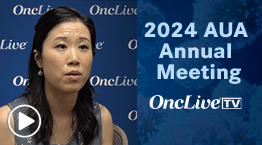The First Oral GNRH Receptor Antagonist for Advanced Prostate Cancer
Neal Shore, MD, discusses the recent FDA approval of the first oral GNRH receptor antagonist, relugolix, for men with advanced prostate cancer, along with data from the phase 3 HERO trial.
Neal Shore, MD: On December 21, 2020, the FDA approved relugolix, commercially known as Orgovyx. This is the first oral GNRH receptor antagonist approved for patients who would benefit from androgen deprivation therapy [ADT]. This is a real breakthrough in the arena of androgen deprivation therapy. All prior ADT has been parenteral, meaning a subcutaneous or intramuscular injection.
Relugolix is a GNRH antagonist, as opposed to all the parenteral LHRH agonists. It’s a similar antagonist to degarelix, which is given via a deep subcutaneous injection. The obvious advantage is the mechanism of action. Within a matter of days, it lowers the testosterone [T] to castrate levels and achieves what you’re trying to do, when appropriate for a patient with advanced prostate cancer.
The LHRH agonist formulations all have a superphysiological surge of LH [luteinizing hormone], FSH [follicle stimulating hormone], and therefore, testosterone. For the first 2 weeks, it’s somewhat counterintuitive to what you’re trying to accomplish. It’s the only pill that’s available. The first day the patient takes 3 pills, then it’s 1 pill once a day; there’s no food-effect requirement. This is particularly advantageous to patients for whom convenience is a concern, an issue of travel, but especially during the pandemic, decreasing exposure for both the patient and his family, as well as the clinic for their exposure.
The HERO phase 3 trial had tremendous global participation and Asian, Latin American, European, and North American sites. A steering committee was designed to look at over 900 patients, a 2:1 randomization for patients who required, through the investigator’s assessment, androgen deprivation therapy. About half the patients had a PSA [prostate-specific antigen] biochemical relapse. About 25% had high-risk, locally advanced disease, who were not deemed appropriate for an interventional treatment, such as surgery or radiation, and another quarter had metastatic disease. Our primary outcome measure was testosterone suppression from day 28 through 48 weeks. Then multiple key secondary end points of profound T suppression, PSA suppression, safety, and tolerability. There was a subset of the population, about 184 patients with a 2:1 randomization, looking at early T recovery at the end of 48 weeks.
We found that the biostatistical analysis demonstrated first a noninferiority to LHRH. Then with a second review, we were able to claim superiority, essentially a near 97% sustained T suppression from day 29 through week 48. The LHRH formulation was approximately 89%. In a subset population, we saw patients had about 53% by day 90 had a testosterone return to u-gonadal levels, whereas only 3% of the LHRH population returned to u-gonadal levels by day 90.
In terms of toxicities, they were consistent in both arms, the relugolix and LHRH agonist arms, consisting of the usual hot flashes and loss of libido. These were not dissimilar in either arm. What was particularly noticeable is that a prespecified safety analysis, there was a 54% decrease in cardiovascular events in the relugolix arm vs the LHRH agonist arm.
Patients who’d had any major adverse cardiovascular event, a myocardial infarction, or a stroke within 6 months of starting the study were excluded from being in the trial. We had 14% of patients who’d had a MACE [major adverse cardiovascular event] prior to the 6-month exclusion, and there was a near 2-fold decrease in cardiovascular events in the relugolix arm. When we looked in the entirety of the population, looking at the patients who had a MACE 6 months prior to entry, it was nearly a 5-fold decreased risk of a MACE, in the relugolix arm vs the LHRH agonist arm.
The trial was published in the New England Journal of Medicine, and it had 2 plenary presentations at ASCO [American Society of Clinical Oncology Annual Meeting] 2020 and AUA [American Urological Association Annual Meeting] 2020, reviewing the data. There is a unique opportunity to start a patient on a pill formulation, 1 pill once a day, instead of requiring them to come into a clinic to get an injection. There is excellent testosterone suppression, which is the pharmacological end point for all the ADT formulations, and a safety profile that had a 54% decrease in cardiovascular events. Unfortunately, most patients who require ADT have cardiovascular risk, more than 90%. Oftentimes that is by the nature of their older age but also because of issues like obesity, dyslipidemia, hypercholesterolemia, diabetes, hypertension, or prior arrhythmia. It’s not all patients, but it can be upward of 30% in some populations, and even higher, depending upon where you are in the globe and their prior cardiovascular history. This formulation—its convenience, its T suppression, and its cardiovascular safety profile—augments nicely for many patients considering androgen deprivation therapy.
Transcript Edited for Clarity



